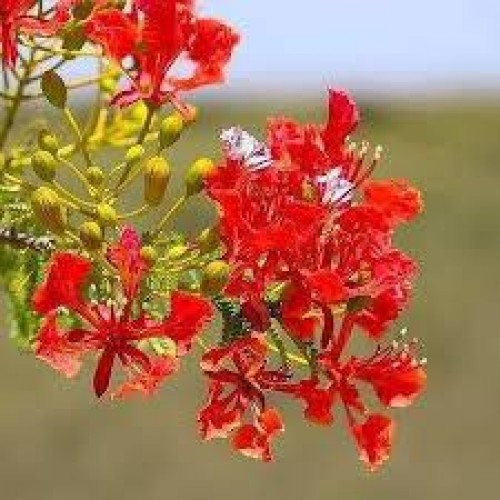60%
off
off
-
Sold
-

out
Gulmohar Tree (Delonix regia)
Botanical Features & Nature
- Scientific Name: Delonix regia
- Common Names: Gulmohar, Flame Tree, Royal Poinciana, Peacock Flower
- Family: Fabaceae (Legume family)
- Origin: Native to Madagascar
- Height: Typically grows between 10 to 12 meters (33 to 40 feet)
- Leaves: Bipinnate, feathery leaves with a bright green hue
- Flowers: Large, showy, red-orange flowers with five petals; blooms in summer
- Fruit: Long, flat, woody seed pods up to 60 cm in length
Care & Cultivation
- Sunlight: Requires full sun exposure for optimal growth and flowering.
- Soil: Prefers well-drained, fertile soils; adaptable to various soil types.
- Watering: Regular watering during the establishment phase; once mature, it is drought-tolerant.
- Fertilization: Apply organic compost or balanced fertilizers during the growing season to promote healthy growth.
- Pruning: Prune in late winter or early spring to remove dead or diseased branches and to shape the tree.
- Propagation: Commonly propagated through seeds; seed pods can be collected, and seeds soaked before planting to enhance germination.
Uses & Benefits
Medicinal Applications
- Leaves: Used to treat wounds and skin conditions.
- Bark & Roots: Employed in remedies for diabetes, diarrhea, and inflammation.
- Flowers: Known for calming effects, aiding in stress reduction.
- Fruits: Consumed to alleviate digestive issues and combat anemia.
Environmental Significance
- Soil Conservation: Extensive root system helps prevent soil erosion.
- Air Purification: Dense foliage acts as a natural air filter.
- Biodiversity Support: Provides habitat and food for various wildlife species.
Cultural Importance
- Mythological Associations: Linked to Lord Krishna and other deities.
- Religious Practices: Considered sacred; often planted near temples and used in ceremonies.
Advantages of Planting Gulmohar
- Rapid Growth: Ideal for quick afforestation and providing shade.
- Low Maintenance: Requires minimal care once established.
- Multipurpose Use: Serves ornamental, medicinal, environmental, and cultural purposes.
- Aesthetic Appeal: Enhances landscapes with lush foliage and fragrant flowers.
Religious Significance
- Hinduism: Associated with Lord Krishna; believed to be the site of his divine plays.
- Festivals: Celebrated during festivals like Janmashtami; flowers offered in temples.
- Symbolism: Represents love, devotion, and spiritual awakening.